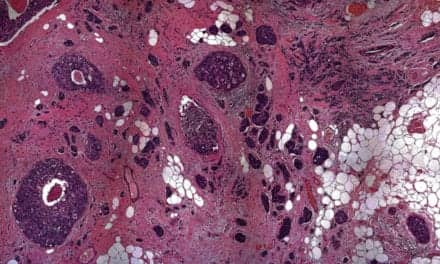By Tom Bittick
Summary:
Emerging liquid biopsy techniques enable sensitive, routine monitoring of ESR1 mutations in metastatic HR+ breast cancer, allowing timely use of targeted therapies that significantly improve patient outcomes.
Takeaways:
- Treatment resistance in HR+ breast cancer is often driven by ESR1 mutations, which are rare at diagnosis but common after endocrine therapy.
- A new liquid biopsy approach combining exosomal RNA and cfDNA boosts mutation detection sensitivity and enables affordable, minimally invasive routine monitoring.
- Clinical trials (e.g., PADA-1, SERENA-6) show that switching to ESR1-targeted therapies at the point of molecular progression—rather than waiting for imaging-confirmed relapse—substantially improves progression-free survival and quality of life.
There’s a cruel paradox for patients with cancer: the very treatments intended to eradicate tumors often trigger changes in the tumor DNA, making these cancers resistant to treatment and allowing them to grow even more aggressively. This chain of events occurs with high frequency among patients with metastatic hormone receptor-positive (HR+) breast cancer, who are typically treated with endocrine therapies.
Among these patients, mutations in the ESR1 gene are almost nonexistent in treatment-naïve cancers. But after receiving an endocrine therapy (+CDK4/6 inhibitor, the established standard of care)—and especially if that therapy was an aromatase inhibitor—up to 40% of these patients have been found to have mutations in the tumor’s ESR1 gene.1 Endocrine therapies work by depriving a tumor of the estrogen it uses for fuel, but certain acquired ESR1 mutations allow tumors to continue growing with other energy sources. These mutations indicate resistance to treatment; when they arise, patients who had been responding well to treatment often relapse.
Fortunately, there are emerging cancer therapies designed to target ESR1 mutations. But a precision oncology approach requires knowing when to incorporate one of these therapies for a patient’s treatment plan—no easy feat with standard clinical practices.
ESR1 Testing Should Be Routine
While ESR1 testing is performed when cancer progression is detected through imaging, the ideal answer lies in routine ESR1 mutation monitoring for patients with metastatic HR+ breast cancer during the course of their endocrine therapy treatment. However, conventional testing approaches may not be sensitive enough to detect these mutations as they emerge, and those that have the required sensitivity tend to be prohibitively expensive for routine use. Of course, for regular monitoring, a test would also have to be minimally invasive.
A new approach to ESR1 mutation testing comes from the interrogation of exosomal RNA plus cell-free DNA (cfDNA) through a liquid biopsy. By combining the signal from both sources, this technique has significantly higher sensitivity than liquid biopsy tests based on cfDNA or circulating tumor DNA (ctDNA) alone. With this increased signal, the test can be run on readily available qPCR equipment, making it a feasible and practical option for any clinical laboratory.
New Therapy Options
Oncology teams now have access to FDA-approved therapies designed to target ESR1 mutations; these include fulvestrant and elacestrant, with other candidate therapies in development. Clinical data has already shown that when patients with certain ESR1 mutations are switched to one of these targeted therapies, tumors can again become responsive to treatment. The outcomes have been so clear that both the National Comprehensive Cancer Network and the American Society of Clinical Oncology are expected to update their clinical practice guidelines with recommendations for the use of ESR1-targeted therapies and for monitoring ESR1 mutations among patients with estrogen receptor-positive metastatic breast cancer.2
These guideline updates have been supported by a number of clinical trial reports. In a phase 3 trial called PADA-1, for example, researchers are tracking approximately 1,000 patients with HR+ metastatic breast cancer to understand how a shift to an ESR1-targeted therapy affects cancer growth.3 In one arm of the trial, patients are tested every other month for ESR1 mutations, and switched to fulvestrant if a mutation is detected. The trial also includes an arm where patients are shifted to fulvestrant only when tumor growth is seen on imaging scans, which more closely represents the standard of care. The trial has not yet been completed but results so far indicate that frequent monitoring makes a difference: patients who were moved to fulvestrant based on mutation detection had more than twice the progression-free survival of a control group that stayed on endocrine therapy, but patients who were given fulvestrant based on imaging data experienced little improvement.4, 5
In another set of trials called SERENA, researchers are evaluating camizestrant, a new treatment that targets ESR1 mutations. In a phase 3 study of more than 3,200 patients, participants were tested every two to three months for emerging ESR1 mutations without progression seen on imaging. In cases where mutations emerged, half were switched to camizestrant while the other half continued conventional treatment. Progression-free survival improved for participants on camizestrant, with a median PFS of 16 months compared to 9.2 months for the control group.6 Patient-reported data was even more stark: those on camizestrant reported a median time of 23 months to reach deterioration in global health status and quality of life, much better than the 6.4 month median reported by participants on conventional therapy. The SERENA-6 phase III clinical trial is the first registrational trial for a new drug based on administration at molecular progression versus anatomical progression. Camizestrant was granted fast track designation status by the FDA.
Detecting ESR1 Mutations
With conventional testing approaches lacking the required sensitivity to spot low-level signals of emerging ESR1 mutations, researchers have had to get creative. In the PADA-1 trial, for example, the team used droplet digital PCR for its monitoring process. The technique may work in a clinical study, but it’s less promising for routine clinical use. Droplet digital PCR is too expensive and complex for most clinical laboratories; it also requires a large number of reactions that need more material than a liquid biopsy test can collect.
Next-generation sequencing has also been considered for this type of work. But it has a capacity problem: using this technology to scan a single gene would be overwhelmingly expensive, and useful only with a very large number of samples that have to be run together. On the other end of the spectrum, whole genome sequencing or whole exome sequencing are standard practice for cancer samples. These are often used very early in the process, prior to treatment, when ESR1 mutations have not yet arisen. At later stages, such a broad approach is unnecessary, because changes to the ESR1 gene are the go-to mutation for this type of cancer as it evolves against endocrine therapy. There’s rarely a need to profile the tumor’s entire genome or exome when this gene is where most of the action takes place. And since ESR1 mutations are acquired genetic events, typically found at subclonal levels, testing during or after endocrine therapy treatment is better performed by plasma-based assays with deep sensitivity.
Detecting pathogenic ESR1 mutations requires a highly sensitive molecular assay, and there’s a more reliable and affordable option than exome or genome sequencing. Recent advances in analyzing exosomal RNA alongside cfDNA have led to a cost-effective, qPCR-based method that any laboratory can implement to enable ESR1 mutation testing. The use of abundant exosomal RNA boosts the biological signal, and combining it with cfDNA ensures that tumor-specific markers are captured. Because all of this information is available from a blood sample, ESR1 testing can now be performed with a simple and minimally invasive liquid biopsy.
Results from this approach have been presented at major clinical and laboratory conferences. At the annual meeting of the Association for Molecular Pathology in 2024, researchers showed that the test was sensitive enough to serve as the basis for reliable ESR1 mutation monitoring; nearly a dozen actionable mutations could be identified with as few as 10 variants in a background of 10,000 wild type copies.7 More recently, at the ESMO Breast Cancer Annual Congress this year, researchers presented data demonstrating the ability to detect 11 clinically relevant ESR1 mutations with a limit of detection lower than 0.1% in a workflow that takes less than a day.8
Looking Ahead
The importance of testing for ESR1 mutations in patients with metastatic HR+ breast cancer has been well established. Clinical laboratory teams may choose to implement such testing only at the point of imaging-denoted progression, or they may opt for a more proactive approach of regular monitoring during the use of endocrine therapy based on results from studies such as the PADA-1 trial. Either way, it is critical that labs take action now to incorporate ESR1 testing to bring the benefits of a precision oncology approach to this group of patients. In the future, monitoring for ESR1 mutations will support a promising care paradigm in metastatic breast cancer: allowing for treatment intervention at molecular progression to help rescue patients before treatment failure presents a more formidable challenge in optimizing care.
ABOUT THE AUTHOR

Tom Bittick is the senior product manager, Oncology, for Asuragen, a Bio-Techne brand.
Featured Image: Svitlana Kuchina | Dreamstime.com
References
- Hermida-Prado F, Jeselsohn R. The ESR1 mutations: from bedside to bench to bedside. Cancer Res. 2021;81:537–8.
- Burstein HJ, DeMichele A, Somerfield MR, Henry NL; Biomarker Testing and Endocrine and Targeted Therapy in Metastatic Breast Cancer Expert Panels. Testing for ESR1 Mutations to Guide Therapy for Hormone Receptor-Positive, Human Epidermal Growth Factor Receptor 2-Negative Metastatic Breast Cancer: ASCO Guideline Rapid Recommendation Update. J Clin Oncol. 2023 Jun 20;41(18):3423-3425. doi: 10.1200/JCO.23.00638.
- National Library of Medicine. PAlbociclib and Circulating Tumor DNA for ESR1 Mutation Detection (PADA-1). Available at https://clinicaltrials.gov/study/NCT03079011.
- Bidard FC, Hardy-Bessard AC, Dalenc F, Bachelot T, et al. Switch to fulvestrant and palbociclib versus no switch in advanced breast cancer with rising ESR1 mutation during aromatase inhibitor and palbociclib therapy (PADA-1): a randomised, open-label, multicentre, phase 3 trial. Lancet Oncol. 2022 Nov;23(11):1367-1377. doi: 10.1016/S1470-2045(22)00555-1.
- Helwick, Caroline. PADA-1 Trial: With Early Identification of ESR1 Mutation, Switch to Fulvestrant in Metastatic Breast Cancer. October 10, 2022. The ASCO Post.
- Bidard FC, Mayer EL, Park YH, Janni W, et al. First-Line Camizestrant for Emerging ESR1-Mutated Advanced Breast Cancer. N Engl J Med. 2025 Jun 1. doi: 10.1056/NEJMoa2502929.
- Thibert, Julie R, et al. Development of a Novel Exosome-based, Multiplexed RT-qPCR Technology for Rapid and Accurate Detection of Circulating Tumor Acquired Resistance Variants in ESR1 at ≤ 0.1% Frequency. Poster presented at the annual meeting of the Association for Molecular Pathology. November 14-18, 2023. Salt Lake City, Utah.
- Haynes, BC, et al. Development and evaluation of a highly sensitive qPCR assay for ESR1 mutation monitoring. Poster presented at ESMO Breast Cancer Annual Congress. May 14-17, 2025. Munich, Germany.





